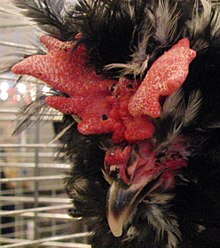Houdan chicken
 A black mottled hen | |
| Other names | French: Poule de Houdan |
|---|---|
| Country of origin | France |
| Standard | Standard-sized (in French) Bantam (in French) |
| Use | meat, eggs, fancy |
| Traits | |
| Weight |
|
| Egg colour | white |
| Comb type |
|
| Classification | |
| APA | continental[1] |
| ABA | all other comb clean legged[1] |
| EE | yes[2] |
| PCGB | rare soft feather: heavy[3] |
| Notes | |
| five-toed | |
| |


The Houdan or Poule de Houdan is an old French
History
The Houdan is a traditional French breed; its origins are unknown. It was described in detail by
: 128It was first imported into England in 1850,[7]: 121 and to North America in 1865, where it appeared in the first edition of the American Standard of Perfection in 1874.[8]: 121
Characteristics
The Houdan is crested, muffed and bearded, has an unusual leaf-shaped comb, and has five toes on each foot rather than the usual four. The earlobes and wattles are small, and may be mostly or completely hidden by the feathering.[9]: 155 The comb is leaf- or butterfly-shaped in European and Australian standards;[9]: 155 in the United States it is v-shaped.[8]: 122
The most common colour variety, and the only one recognised in the United Kingdom, is mottled (or caillouté, "pebbled" in France), a pattern of black with white spotting. In the past there was a lighter variation of the mottled pattern; in the 1800s, it may have been more similar to the splashy mixture of white and black which today is called exchequer.[6] Three other colour varieties are recognised in France: black, pearl-grey, and white.[4]: 131 In the Poultry Standard for Europe of the Entente Européenne d'Aviculture et de Cuniculture the black mottled, cuckoo, pearl-grey and white are recognised; a black variety is listed but unrecognised.[2] The white variety was developed in the United States.[10]: 2 Other colours were known in the past, including blue mottled and red.[11]: 4
Although it is classified by the
: 129Use
The Houdan was formerly a dual-purpose fowl, kept for both eggs and meat: for part of the nineteenth century it was one of the principal meat breeds of France.[: 128
Hens may give some 140–160 eggs per year; they are white, and not large.[14]: 152
References
- ^ a b APA Recognized Breeds and Varieties: As of January 1, 2012. American Poultry Association. Archived 4 November 2017.
- ^ a b Liste des races et variétés homologuée dans les pays EE (28.04.2013). Entente Européenne d’Aviculture et de Cuniculture. Archived 16 June 2013.
- ^ Breed Classification. Poultry Club of Great Britain. Archived 12 June 2018.
- ^ ISBN 9782855573861.
- ^ Charles Emile Jacque (1858). Le poulailler: monographie des poules indigènes et exotiques, aménagements, croisements élève, hygiène, maladies, etc. (in French). Paris: Librairie agricole de la maison rustique.
- ^ a b Charles Lee (1874). A Practical Guide to the Breeding, Feeding, Rearing and General Management of the Houdan Fowl. London: W. Hawkins.
- ISBN 9781405156424.
- ^ ISBN 9781580176675.
- ^ ISBN 9781119509141.
- ^ a b Luuk Hans (February 2009). Vive La France. Aviculture Europe. 5 (1), article 9. Accessed May 2022.
- ^ Craig Russell (2000). Old French Breeds: Houdans and Crevecoeurs. SPPA Bulletin. 5 (2):3–4. Society for Preservation of Poultry Antiquities.
- ISBN 9780715325674.
- ^ Standard de la Houdan (in French). Houdan–Faverolles Club de France. Accessed August 2014.
- ISBN 9780793806010.
